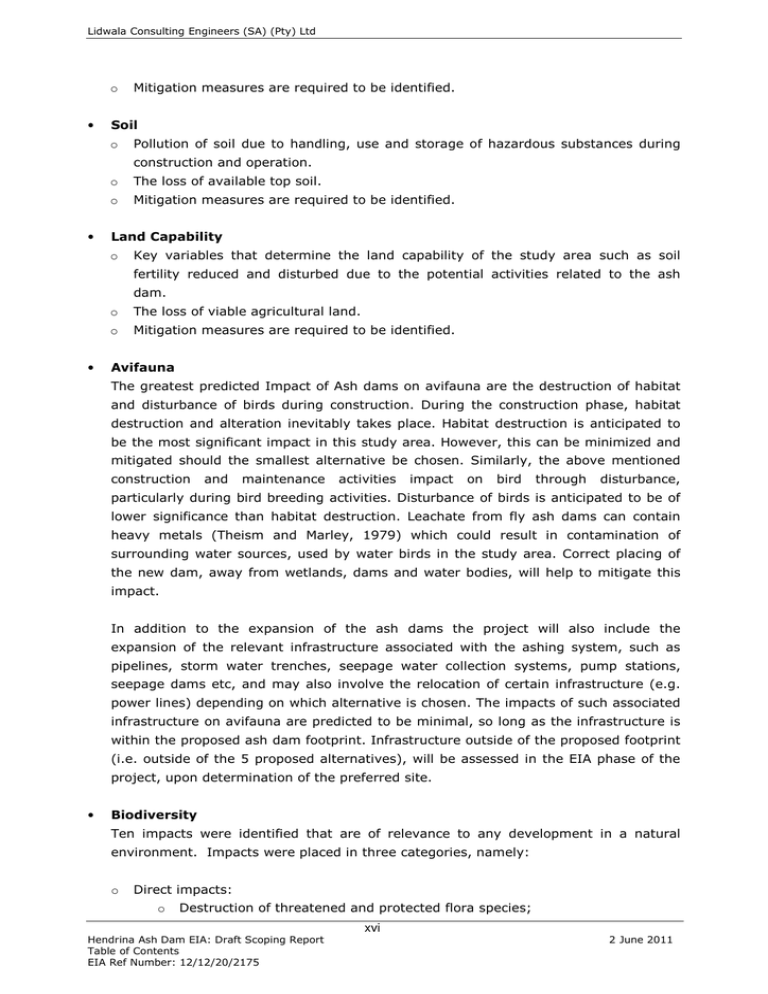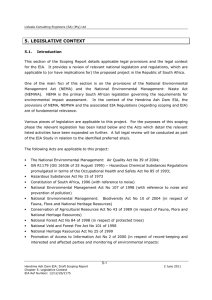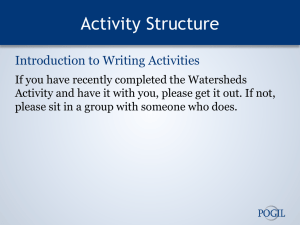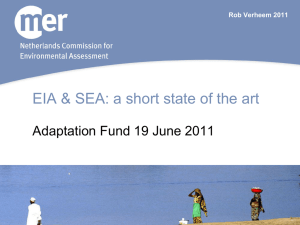Mitigation measures are required to be identified. o Soil
advertisement

Lidwala Consulting Engineers (SA) (Pty) Ltd o • Mitigation measures are required to be identified. Soil o Pollution of soil due to handling, use and storage of hazardous substances during construction and operation. • o The loss of available top soil. o Mitigation measures are required to be identified. Land Capability o Key variables that determine the land capability of the study area such as soil fertility reduced and disturbed due to the potential activities related to the ash dam. • o The loss of viable agricultural land. o Mitigation measures are required to be identified. Avifauna The greatest predicted Impact of Ash dams on avifauna are the destruction of habitat and disturbance of birds during construction. During the construction phase, habitat destruction and alteration inevitably takes place. Habitat destruction is anticipated to be the most significant impact in this study area. However, this can be minimized and mitigated should the smallest alternative be chosen. Similarly, the above mentioned construction and maintenance activities impact on bird through disturbance, particularly during bird breeding activities. Disturbance of birds is anticipated to be of lower significance than habitat destruction. Leachate from fly ash dams can contain heavy metals (Theism and Marley, 1979) which could result in contamination of surrounding water sources, used by water birds in the study area. Correct placing of the new dam, away from wetlands, dams and water bodies, will help to mitigate this impact. In addition to the expansion of the ash dams the project will also include the expansion of the relevant infrastructure associated with the ashing system, such as pipelines, storm water trenches, seepage water collection systems, pump stations, seepage dams etc, and may also involve the relocation of certain infrastructure (e.g. power lines) depending on which alternative is chosen. The impacts of such associated infrastructure on avifauna are predicted to be minimal, so long as the infrastructure is within the proposed ash dam footprint. Infrastructure outside of the proposed footprint (i.e. outside of the 5 proposed alternatives), will be assessed in the EIA phase of the project, upon determination of the preferred site. • Biodiversity Ten impacts were identified that are of relevance to any development in a natural environment. Impacts were placed in three categories, namely: o Direct impacts: o Destruction of threatened and protected flora species; xvi Hendrina Ash Dam EIA: Draft Scoping Report Table of Contents EIA Ref Number: 12/12/20/2175 2 June 2011 Lidwala Consulting Engineers (SA) (Pty) Ltd o o o Direct impacts on threatened fauna species; o Destruction of sensitive/ pristine habitat types; o Direct impacts on common fauna species; Indirect Impacts: o Floristic species changes subsequent to development; o Faunal interactions with structures, servitudes and personnel; o Impacts on surrounding habitat/ species; Cumulative Impacts: o Impacts on SA’s conservation obligations & targets (VEGMAP vegetation types); o Increase in local and regional fragmentation/ isolation of habitat; and o Increase in environmental degradation. Other, more subtle impacts on biological components, such as changes in local, regional and global climate, effects of noise pollution on fauna species, increase in acid rain and ground water deterioration are impacts that cannot be quantified to an acceptable level of certainty and is mostly subjective in nature as either little literature is available on the topic or contradictory information exist. • Surface Water o Contamination of surface water from seepage and run off. o Loss of aquatic biodiversity. o Loss of runoff into the catchment. o The detailed aquatic ecological impact assessment will quantify the significance of possible impacts associated with the preferred site. • Groundwater o Contamination of ground water due to hydrocarbon spillage and seepage into groundwater reserves, affecting groundwater quality. o Mitigation measures are required to be identified. o Further construction of infrastructure and compaction of the area will further contribute to reduced water infiltration rates to replenish groundwater aquifers. Mitigation measures are required to be identified. • Noise o • Change in ambient noise levels during both construction and operation. Air Quality o Increase in dust generating activities during construction and operation including exceedances of PM10 concentrations and exceedances of dustfall rates. o Mitigation measures may be required to be identified if required. Socio-Economic Impacts – Ash Dam: • Visual impacts of preferred site xvii Hendrina Ash Dam EIA: Draft Scoping Report Table of Contents EIA Ref Number: 12/12/20/2175 2 June 2011 Lidwala Consulting Engineers (SA) (Pty) Ltd • Disturbance of cultural or historical sites • Economic benefits through employment • Continued generation of Electricity over the long term at Hendrina Power Station • Health risks from elevated PM10 concentrations and dust fall rates • Loss of groundwater resource to local users (in terms of potential groundwater contamination) • Inflow of temporary workers. • Mitigation measures are required to be identified. Potential Impacts associated with relocating the Powerlines at Alternative E • Visual impact of the new power line routes and proposed tower structures; • Loss of land capability if relocated over agricultural land and the loss of available top soil; • Loss of aquatic habitat and contamination of surface water ecosystems due to sedimentation; • Loss of biodiversity and habitats; • Potential groundwater contamination due to chemical spillage during construction; • Collisions and electrocutions of birds; • Disruption of land use and loss of economic potential; and • Increase in health risk to neighbouring residents due to EMF. The above mentioned impacts will be investigated in more detail during the EIA phase of the project. 7 CONCLUSIONS AND RECOMMENDATIONS Based on the desktop studies undertaken to date no environmental fatal flaws (excluding those listed by the DEA Minimum Requirements for Waste Landfill) have been identified that would prohibit the project from continuing at this stage of the process. However, a number of potentially significant environmental impacts have been identified as requiring some more in-depth investigation and the identification of detailed mitigation measures. Therefore, a detailed Environmental Impact Assessment is required to be undertaken in order to provide an assessment of these potential impacts and recommend appropriate mitigation measures, where required. The recommendation of this report is that detailed specialist studies are undertaken on the preferred site (Alternative E) and the no-go alternative. In addition to this the specialist will also be required to assist in the identification of alternative corridors for the re-routing of the powerlines that traverse Alterative E as well as to investigate and assess the potential impacts associated with the relocation of the powerlines. xviii Hendrina Ash Dam EIA: Draft Scoping Report Table of Contents EIA Ref Number: 12/12/20/2175 2 June 2011 Lidwala Consulting Engineers (SA) (Pty) Ltd Eskom Holdings Limited Environmental Impact Assessment for the Proposed Expansion of Ash Disposal Facilities at Hendrina Power Station, Mpumalanga Province Draft Scoping Report TABLE OF CONTENTS Item Description Page No. Document Description Executive Summary Table of Contents 1. INTRODUCTION 1-1 1.1 Need and Justification 1-2 1.2 Project Background 1-3 1.3 Summary of EIA Process 1-4 1.3.1 EIA Process 1-4 1.3.2 Application Process 1-4 1.3.3 Scoping Phase 1-6 1.3.4 EIA or Assessment Phase 1-7 1.4 Way Forward 1-8 2. DETAILS OF ROLE PLAYERS 2-1 2.1 Introduction 2-1 2.2 Details of Appicant 2-1 2.3 Details of Independent Environmental Assessment 2-1 2.4 Details of Competent / Relevant Authority 2-4 2.5 Details of Commenting Authorities 2-4 3. PROJECT DESCRIPTION 3-1 3.1 Introduction 3-1 3.2 Location of the proposed Site for Expansion 3-2 3.3 Detailed Description of the Project 3-5 4. PROJECT ALTERNATIVES 4-1 4.1 Introduction 4-1 4.2 The ‘No-go’ Alterantive 4-1 4.3 Ash Disposal Method 4-2 4.4 Location Alternatives 4-3 4.4.1 Screening Analysis and Methodology 4-5 4.4.2 Final Screening Results 4-12 4.5 Conclusion 4-21 Practitioner xix Hendrina Ash Dam EIA: Draft Scoping Report Table of Contents EIA Ref Number: 12/12/20/2175 2 June 2011 Lidwala Consulting Engineers (SA) (Pty) Ltd 5. LEGISLATIVE CONTEXT 5-1 5.1 Introduction 5-1 5.2 Legal Review 5-2 5.2.1 Waste Management 5-2 5.2.2 Water Consumption and Disposal 5-4 5.2.3 EIA Activities 5-5 6. EIA PROCESS AND METHODOLOGY 6-1 6.1 Introduction 6-1 6.2 Authority Consultation 6-1 6.2.1 Consultation with Authorities 6-1 6.2.2 Consultation with other Relevant Authorities 6-2 6.3 Environmental Scoping Study 6-2 6.3.1 Overview of the Public Participation Process 6-2 6.3.2 Public Review of the Draft Environmental Scoping Report 6-8 6.3.3 Final Environmental Scoping Report 6-9 6.4 Conclusion 6-9 7 DESCRIPTION OF BASELINE ENVIRONMENT 7-1 7.1 Introduction 7-1 7.2 Study Area in Regional Context 7-1 7.2.1 Locality 7-1 7.2.2 Study Area 7-1 7.3 Description of the Baseline Environment 7-5 7.3.1 Topography 7-5 7.3.2 Climate 7-5 7.3.3 Geology 7-6 7.3.4 Land Cover and Land Use 7-6 7.3.5 Natural Vegetation 7-8 7.3.6 Animal Life 7.3.7 Macro Habitats 7-10 7-9 7.3.8 Avifauna 7-11 7.3.9 Surface Water 7-15 7.3.10 Ground Water 7-19 7.3.11 Site of Archaeological, Historical and Cultural Interest 7-22 7.3.12 Visual Impacts 7-22 7.3.13 Social Environment 7-25 8. POTENTIAL IMPACTS AND SITE SELECTION 8-1 8.1 Introduction 8-1 8.2 Alternative Site Selection 8-1 8.2.1 Alternative Site Ranking Criteria 8-1 8.2.2 Alternative Site Discussion 8-3 8.2.3 Final Alternative Site Ranking 8-21 8.2.4 Minimum Requirements for Waste Disposal by Landfill: Fatal 8-22 8.2.5 Final Discussion 8-24 8.3 Summary of Significant Impacts identified during Scoping 8-26 Flaws xx Hendrina Ash Dam EIA: Draft Scoping Report Table of Contents EIA Ref Number: 12/12/20/2175 2 June 2011






